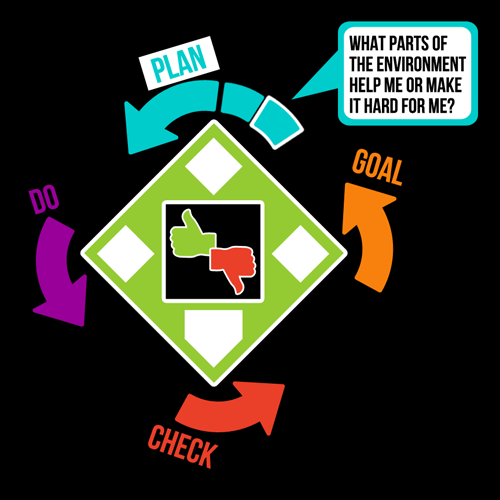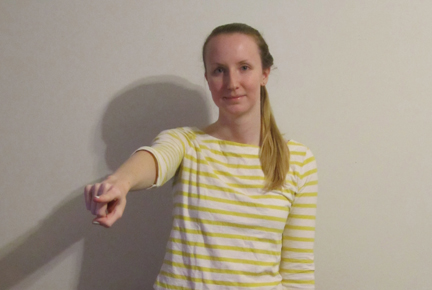Second Base: Plan Step 3
Contents
- Second Base: Plan Step 3 Introduction
- Why is it important to think about others?
- Second Base: Plan Step 3 Game Plan Worksheet
Second Base of the Game Plan is called Second Base: Plan. When we plan, we think of ways to meet our goal. Second Base: Plan has three steps, or three things we have to think about. The second step of Second Base is Plan: Step 3. During Plan: Step 2, we ask the question, “Would using this strategy change the activity for other people?”
Each base of the Game Plan has a hand motion to help us remember what it means. When we ask, “Would using this strategy change the activity for other people?,” we make the motion of pointing around the room which represents that I am pointing to and thinking about other people.
Another way to remember that Second Base: Plan Step 3, is by remembering the symbol. The symbol for Second Base: Plan Step 3 is a group of people.
Now it’s time to ask yourself the Second Base: Plan Step 3 question: “Would using this strategy change the activity for other people?”
In Project TEAM, we learn that different things might happen when we use strategies to change the environment. Sometimes when we use a strategy to change the environment, we will also change the activity for other people. These are called consequences, or things that might happen because of our actions. Even though a strategy might help you to do an activity, there can still be consequences for other people.
Some consequences might be that the strategy might help or make it harder for other people to do the activity, or the strategy might make the activity more or less fun for them. It is important to think about how a strategy will change the activity for other people before you decide if you want to use that strategy. But sometimes you may still want or need to use a strategy, even if it makes an activity harder or less fun for other people.
Would using this strategy change the activity for other people?
In order to answer this question, we first have to think about what kinds of people are involved in your activity. Just like not all parts of the environment are involved in every activity, not all of kinds of people are involved in every activity. For example, if your activity goal is to participate in a sports club at your school, “family” might not be involved in your activity.
Download and print out the Second Base: Plan Step 3 Game Plan Worksheet. Think about the strategies you decided to use to work around the barriers in your activity goal. Pick one, and write it on the line on the Game Plan Worksheet where it says, “Choose 1 strategy.”
For each strategy, you will first need to think about all the different people who may be involved in your activity and who could be affected if you change the environment. The first column says, “Who is involved in this activity or making this change.” If a person is not involved in using your strategy, put a check in the box next to the word, “No,” and go onto the next person. If a person is involved in using your strategy, put a check in the box next to the word, “Yes,” then go to the next column.
In the next two columns, we are thinking about consequences, or things that might happen because of our actions. The next column asks the question, “Would using this strategy help or make it harder for someone else to do the activity?” Thinking of the person or people involved in using your strategy, answer the question. If your strategy would help that person, put a check in the box next to the word, “Helps,” with the green thumbs up symbol. If your strategy would make the activity harder for that person, put a check in the box next to the word, “Harder,” with the red thumbs down symbol. If your strategy would not help OR make the activity harder for that person, put a check in the box next to the words, “No Change.” Then go to the next column.
The next column asks the question, “Would using this strategy keep the activity fun for other people?” Thinking of the person or people involved in using your strategy, answer the question. If your strategy would keep the activity fun for that person, put a check in the box next to the word, “Fun.” If your strategy would make the activity less fun for that person, put a check in the box next to the words, “Less Fun.”
Once you are finished answering the questions for the first kind of person involved in using your strategy, you can go onto the next person. At the very bottom of the page, you can add up the number of people that may be helped if you use your strategy, or that may have a harder time doing the activity if you used this strategy. You can also add up the number of people that may have more fun or less fun if you use this strategy. If using your strategy makes it harder for more people, or less fun for more people, you may want to think about using a different strategy. But remember, sometimes you may still want or need to use a strategy, even if it makes an activity harder or less fun for other people.
Ready to learn more?
Go on to the next part of the Game Plan:



